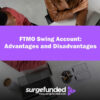Risk management in funded accounts is a crucial component of managing a funded account successfully for traders in any financial market, but especially forex trading. Trading requires effective risk management, particularly when working with funded accounts. Prop firm’s usually offer funded accounts, which give traders access to large amounts of capital without putting their own money at danger. On the other hand, it is crucial to manage that capital well and reduce risks. The significance of risk management in funded accounts, the kinds of risks involved, and methods for successfully managing those risks are all covered in this article.
Understanding Funded Accounts
A funded account is a trading account that receives funding from a prop firm. Before being given access to these accounts, traders are assessed on their abilities and compliance with risk management procedures. Enabling traders to profit from market movements while lowering personal financial risk is the main objective of funded accounts.
Elements of Funded Accounts
- Cash Provision: Traders are able to take on bigger bets than they might with their own money since they have access to a significant amount of cash.
- Profit Sharing: Usually between 70% and 90% of the earnings made from trades are kept by the traders.
- Assessment Procedure: The majority of firms demand that traders complete an assessment stage in which they exhibit their trading prowess and compliance with risk management guidelines.
- Guidelines for Risk Management: To safeguard their money, prop firm’s enforce stringent rules on maximum drawdowns, daily loss caps, and position sizes.
- Educational Support: To assist traders in developing their expertise, numerous firm’s offer resources including mentorship and training courses.
The Significance of Risk Control
A number of factors make effective risk management crucial, including:
- Capital Preservation: Safeguarding the firm’s capital is the main goal of risk management in funded accounts. Traders can extend their time in the game and give themselves the chance to bounce back from defeats by reducing their losses.
- Emotional Control: In times of market volatility, traders can preserve emotional stability by controlling risk. Fear and greed can cause people to make snap decisions that cost them a lot of money.
- Long-Term Success: Making money is only one aspect of successful trading; another is skillfully handling losses. Traders can stay in the market longer and take advantage of lucrative opportunities over time with a good risk management plan.
- Compliance with Firm Policies: Traders are required to abide by stringent risk management guidelines set forth by prop firms. Maintaining access to funded accounts and avoiding penalties require adherence to these rules.
Types Of Risk In Funded Accounts
Traders who manage funded accounts run the following kinds of risks:
- Market Risk: Market risk is the possibility of suffering losses as a result of shifts in market pricing. Economic news, geopolitical developments, or shifts in market mood can all have an impact on market swings.
- Liquidity Risk: The worry that traders won’t be able to purchase or sell assets fast enough without materially altering their prices is known as liquidity risk. Liquidity may dry up in rapidly moving markets, resulting in slippage and higher expenses.
- Operational Risks: Risks resulting from internal procedures, system malfunctions, or outside circumstances that could interfere with trade activity are all included in operational risk. It covers problems like human error or technological malfunctions.
- Psychological Risk: When trading under pressure or during times of extreme volatility, the emotional components of the activity might cause bad decisions. A trader’s performance can be greatly impacted by psychological factors.
- Regulatory Risk: Modifications to laws may have an impact on trading plans and business practices. Traders need to be aware of any changes to regulations that could affect their capacity to trade successfully.
Techniques for Effective Risk Management
Traders should use a few crucial tactics for risk management in funded accounts:
1. Clearly Define the Risk Parameters
Applying risk management in funded accounts, clearly defining risk limits is essential.
- Maximum Limits on Drawdown: Establish the highest % loss that can be accepted before you stop trading. By doing this, considerable capital depreciation is avoided.
- Daily Loss limitations: Set daily loss limitations to avoid making rash decisions after suffering losses.
- Rules for Position Sizing: Based on your risk tolerance and total account size, choose the right position sizes. It is generally advised to avoid risking more than 1% to 2% of the entire account balance on a single trade.
2. Put Stop-Loss Orders to Use
Stop-loss orders are crucial instruments for risk management:
- Setting the Levels of Stop-Loss: Instead of placing stop-loss orders at random locations, place them at levels that correspond to support/resistance levels and market volatility.
- Trailing Stops: Take into account employing trailing stops, which lock in profits while guarding against reversals by adjusting when the market shifts in favor of the position.
3. Trade Diversification
In order to reduce the risks associated with concentrated positions, diversification is essential:
- Asset Class Diversification: To reduce correlation between investments, distribute your money among several asset classes or currency pairs.
- Strategy Diversification: To successfully balance risk and return profiles, use a variety of trading techniques, such as swing and day trading.
4. Frequent Evaluation of Performance
Reviewing your trading performance on a regular basis aids in determining your advantages and disadvantages.
- Keep a Trading Journal: Keep track of every trade, including the places of entry and departure, the motivations behind the deals, and the results. Finding trends in profitable and unsuccessful transactions is made easier by analyzing this data.
- Analysis of Performance Metrics: To objectively assess overall performance, use indicators like the win/loss ratio, average gain/loss per trade, and maximum drawdown.
5. Adopt a Culture of Ongoing Education
Because the financial markets are ever-changing, success depends on continual education:
- Keep abreast on market developments: Read economic and market news on a regular basis that could affect asset or currency prices.
- Engage in Training Initiatives: Take advantage of prop businesses’ educational resources or outside classes to improve your trading abilities.
In conclusion
Risk management in funded accounts is a crucial component of effective funded account management for traders in any financial market. Traders can protect their capital and maximize profit potential by understanding the different types of risks involved and putting effective strategies into practice, such as setting clear risk parameters, using stop-loss orders, diversifying trades, routinely reviewing performance metrics, and committing to continuous learning.
Effective risk management not only protects capital but also promotes long-term trading success in a setting where emotional restraint and strict adherence to regulations are critical. Traders must continue to be flexible and dedicated to improving their tactics over time as they negotiate the intricacies of funded accounts, balancing the possibility of profit with rigorous adherence to risk management procedures.
In the end, effective risk management will enable traders to flourish in the cutthroat world of funded trading accounts, opening the door for long-term development and financial success.
Frequently Asked Questions
1. What Are Funded Accounts
- A funded account is a trading account that receives funding from a prop firm. Before being given access to these accounts, traders are assessed on their abilities and compliance with risk management procedures.
2. What Are The Characteristics of A Funded Account
- Cash Provision: Traders are able to take on bigger bets than they might with their own money since they have access to a significant amount of cash.
- Profit Sharing: Usually between 70% and 90% of the earnings made from trades are kept by the traders.
- Assessment Procedure: The majority of firms demand that traders complete an assessment stage in which they exhibit their trading prowess and compliance with risk management guidelines.
- Guidelines for Risk Management: To safeguard their money, prop firm’s enforce stringent rules on maximum drawdowns, daily loss caps, and position sizes.
- Educational Support: To assist traders in developing their expertise, numerous firm’s offer resources including mentorship and training courses.
3. What Are The Significance of Risk Control
They include:
- Capital Preservation: Safeguarding the firm’s capital is the main goal of risk management in funded accounts. Traders can extend their time in the game and give themselves the chance to bounce back from defeats by reducing their losses.
- Emotional Control: In times of market volatility, traders can preserve emotional stability by controlling risk. Fear and greed can cause people to make snap decisions that cost them a lot of money.
- Long-Term Success: Making money is only one aspect of successful trading; another is skillfully handling losses. Traders can stay in the market longer and take advantage of lucrative opportunities over time with a good risk management plan.
- Compliance with Firm Policies: Traders are required to abide by stringent risk management guidelines set forth by prop firms. Maintaining access to funded accounts and avoiding penalties require adherence to these rules.


















